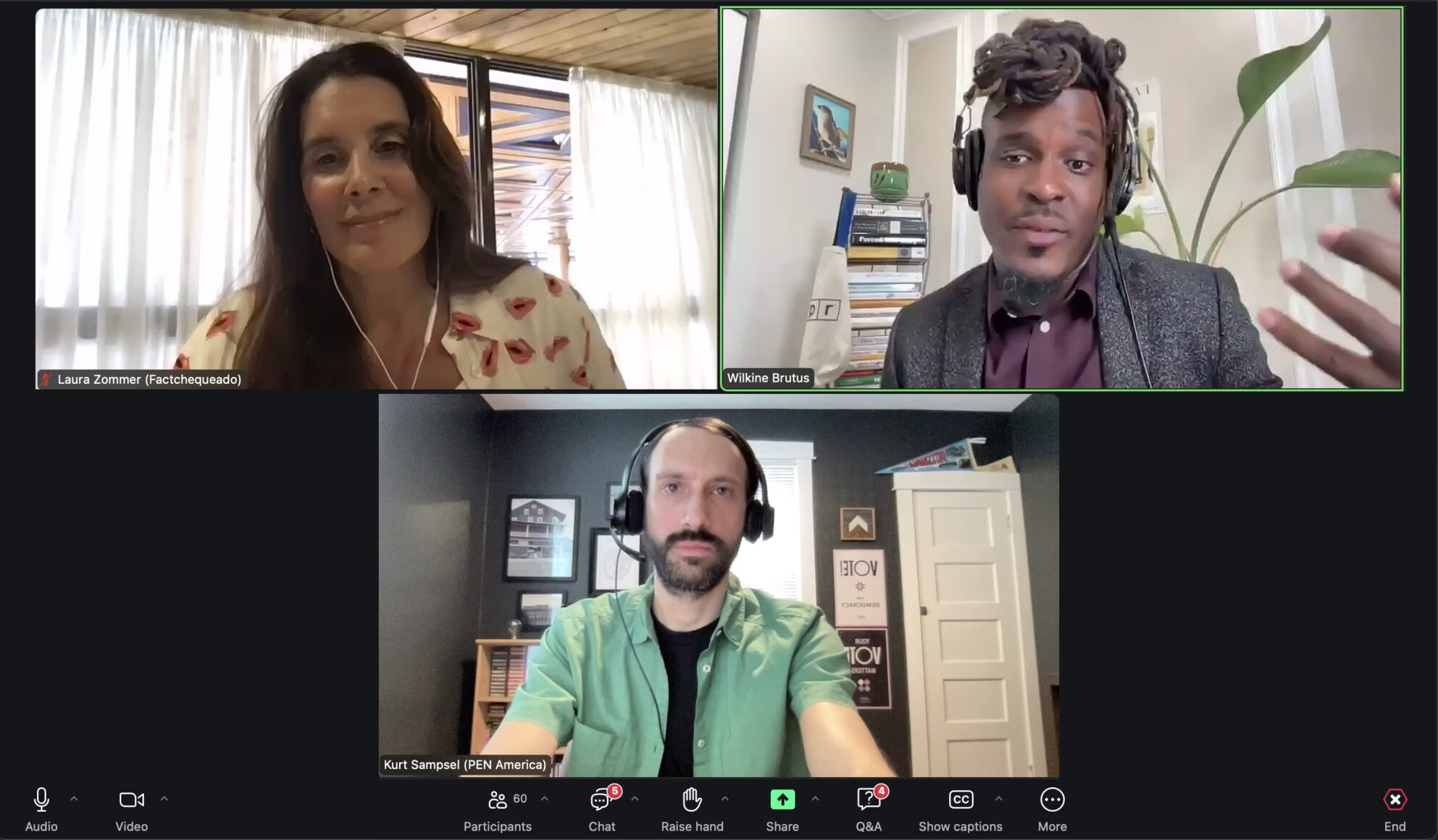With the election season swiftly descending on us and bringing with it its share of mis- and disinformation, it has never been more important to equip journalists with a practical toolkit to combat deception and falsehoods.
PEN America’s Journalism and Disinformation Program Director Tim Richardson and consultant Mina Haq joined Max Read, senior research manager at the think tank Institute for Strategic Dialogue, during a webinar hosted by Election SOS to show how misinformation spreads and how it can be reduced.
Citing research conducted by PEN America, Richardson said 90% of reporters were altering their journalistic practices because of disinformation, and 17% had avoided a story, fearing a “fake news” backlash. Furthermore, 40% of respondents said their newsrooms weren’t equipped to combat disinformation, and 42% said part of their audience had lost trust in them. While disinformation has been around for centuries, access to powerful generative AI tools is exacerbating the problem.
To Fact-Check or Not?
Disinformation isn’t always worth covering, the experts said. Prioritizing what to debunk is an important skill, as covering misinformation gives it more oxygen while exposing it to a wider audience.
Richardson cited studies that indicate publishers of false information record about six times the engagement on their content compared to those producing accurate information. While the goals of disinformers have not changed over the years, powerful AI tools combined with social media distribution have made it easy for anyone to create a disinformation campaign. “It’s like the saying, ‘a lie can travel halfway around the world while truth is still putting its shoes on,’” he said.
Many Ways to Disinform
Disinformation usually appeals to the audience’s emotions and value systems, said Read, whose organization researches disinformation, polarization, and extremism. He outlined some of the tactics disinformers use:
- Repetition: The more that people are exposed to false information, the more likely they are to believe a claim.
- “In-group” language: Terms, slang, or cultural references are used to establish credibility, especially with marginalized communities.
- Appeal to public figures: Influencers, particularly those claiming to be non-partisan, are sought to amplify disinformation narratives.
- Generative AI: Tactics like deep fakes and impersonation disproportionately target women, and facilitate the creation of false information.
- Micro-targeting: AI can spread personalized disinformation, such as incorrect news about nearby polling stations tailored to a single person.
- Flooding the zone: Inundating social media with content to confuse readers, making it harder to discern what is true, is commonly used by those who spread falsehoods.
Read said foreign influence also plays a role in dispersing false information. While disinformers often amplify divisive information generated by Americans, they can also have a foreign policy focus, especially regarding hotspot regions like Ukraine, Taiwan, and Gaza.
“Bad actors” also take advantage of social media features that make it easier for disinformation to spread, using tactics such as gaming trending topics, hashtags, and algorithms that favor verified or premium accounts. Read cautioned against linking directly to posts from fringe sources like Gab, Truth Social, and Telegram – suggesting that journalists avoid driving traffic to these media.
Practical Tips for Journalists
Haq advised journalists to use caution before debunking information – monitoring a post’s virality, reach, and tangible impact. She shared the following tips for journalists who are deciding whether to ignore misinformation or correct it:
- Use the “truth sandwich” model: Start with the correct information, mention the false information, then go back to the correct information with evidence. As some people only skim headlines, it is useful to lead with the truth.
- Highlight verified clips of what a person has said on the same issue if you suspect a deep fake video of a political candidate.
- Allow your audience to flag suspicious media early by creating a tip line, where the public can send video clips, robocalls and other forms of suspected misinformation.
- Use traditional verification methods such as reverse image searches, source interviews, and reaching out to experts.
- Inoculate readers by prebunking misinformation, which exposes the public to correct information and context before a false narrative can set in. For example, during the 2020 elections, newsrooms proactively debunked false claims that delayed election counts would cast doubt on the final results.
- Work with trusted leaders and experts to gain insights and disseminate factual information to the community, keeping in mind that disinformation disproportionately affects marginalized communities.
- Bring empathy and be sensitive, especially to the fact that disinformation can create conflict.
- Provide credible non-English language content through locally used channels like WhatsApp and Telegram.
- Demonstrate transparency by explaining the reporting process, which can help restore trust.
- Limit fact-checks to statements of facts, and reach out to the person who made the suspected false statement for evidence to back up their claim.
- Provide context and give readers a sense of scale in headlines. If there are voting irregularities, for example, also mention that it is extremely unusual.
- Keep a record of disinformation for future reference. Disinformation narratives tend to repeat themselves.
These pointers can help journalists be better prepared ahead of an intense election cycle, Haq said. “Journalists are in the best position to fight that threat and to spread the truth through all of these tools,” she said. “You can’t convince everyone of the truth, but you can convince a lot of people.”










